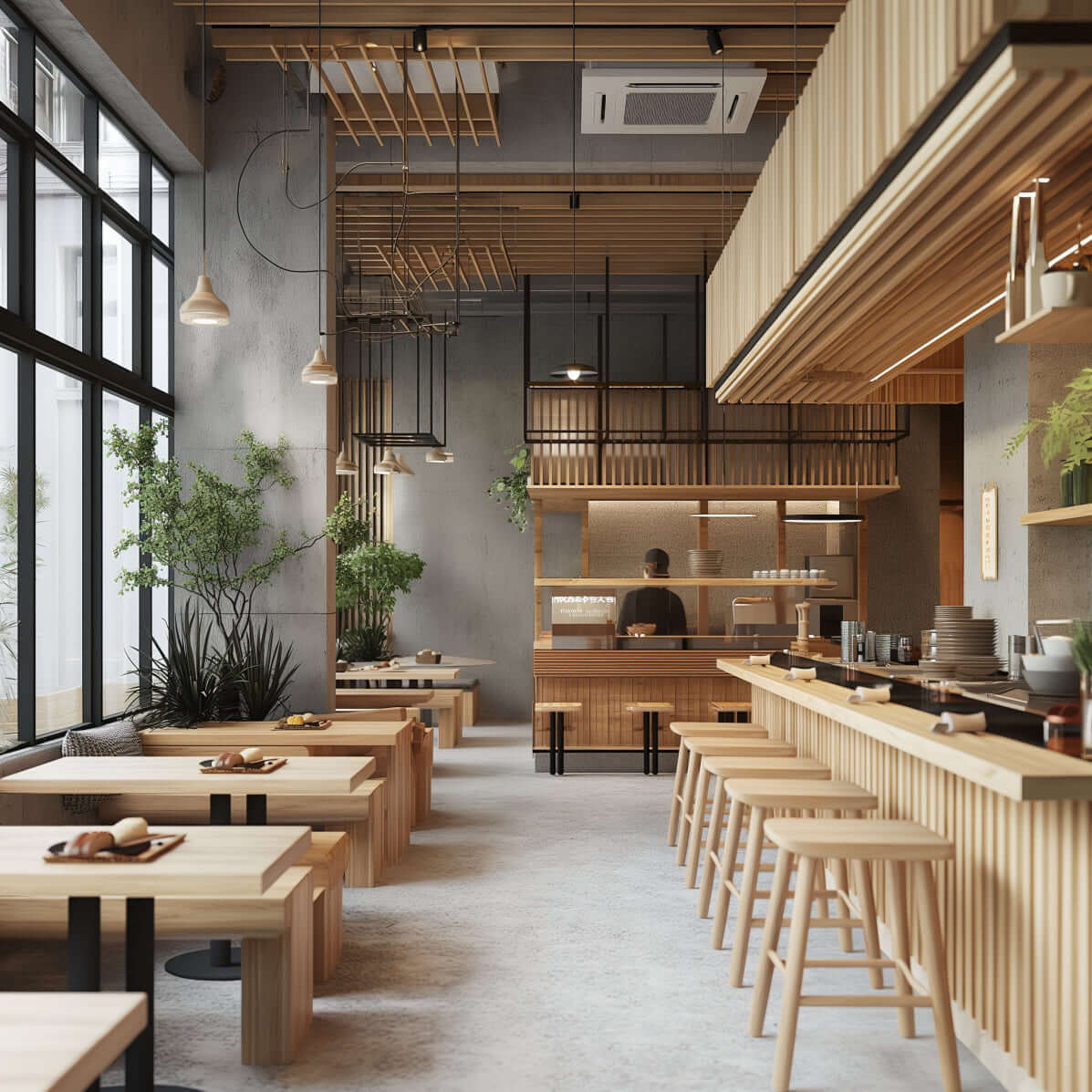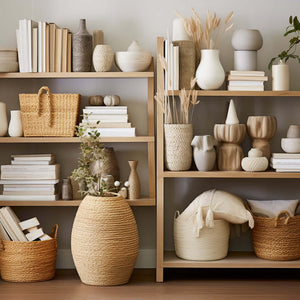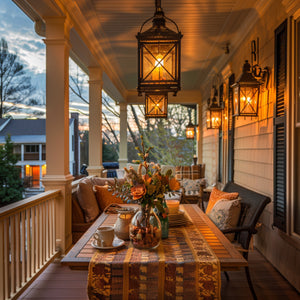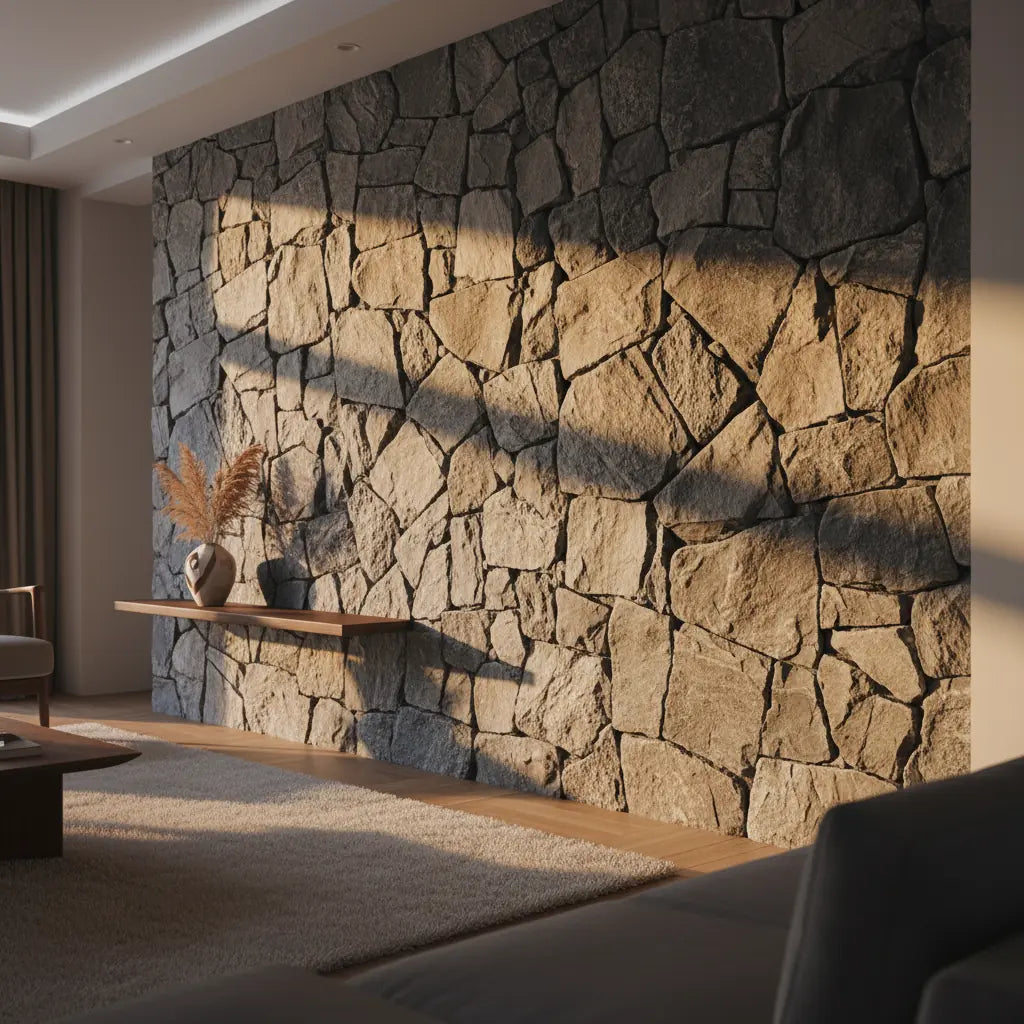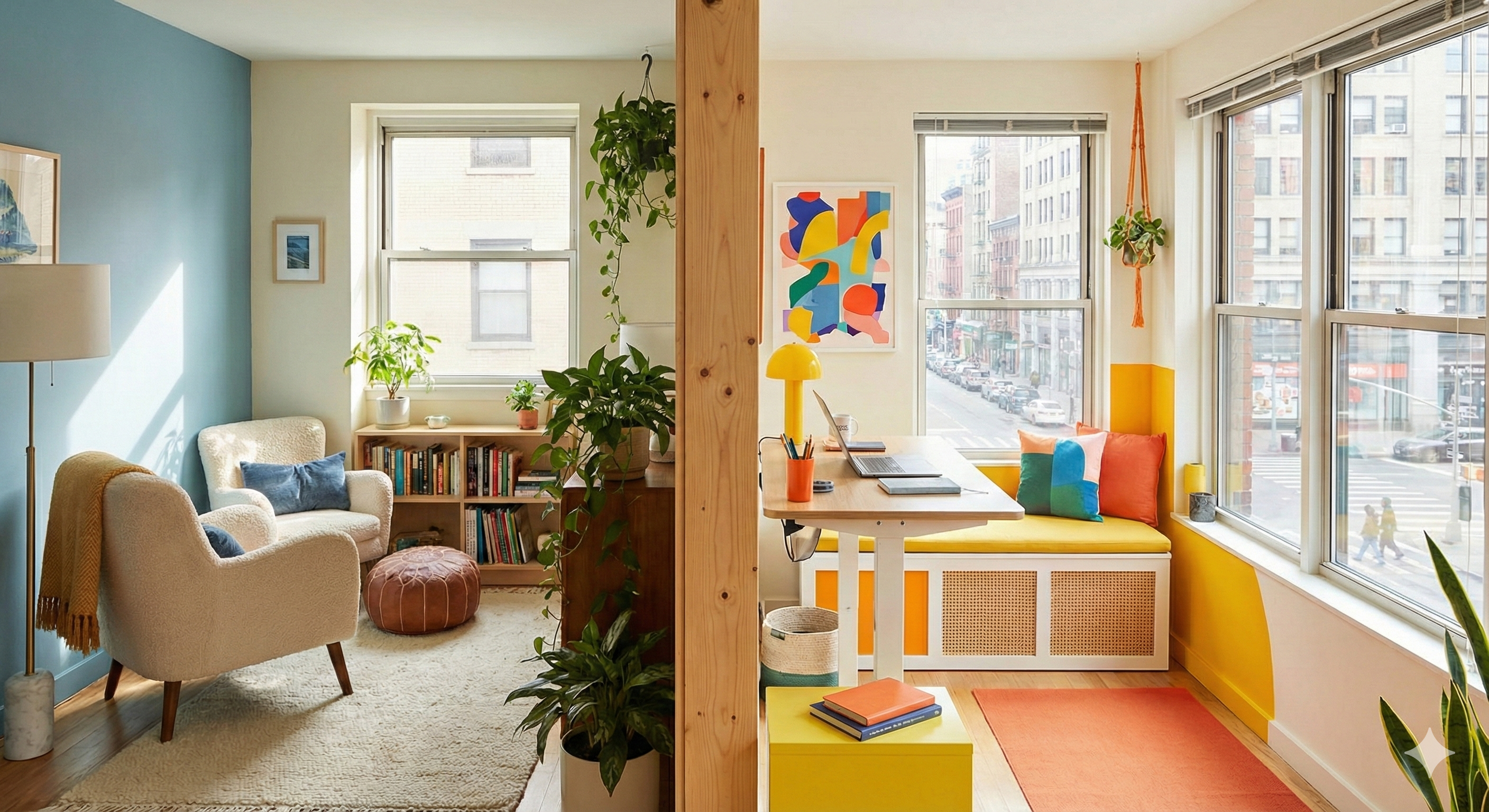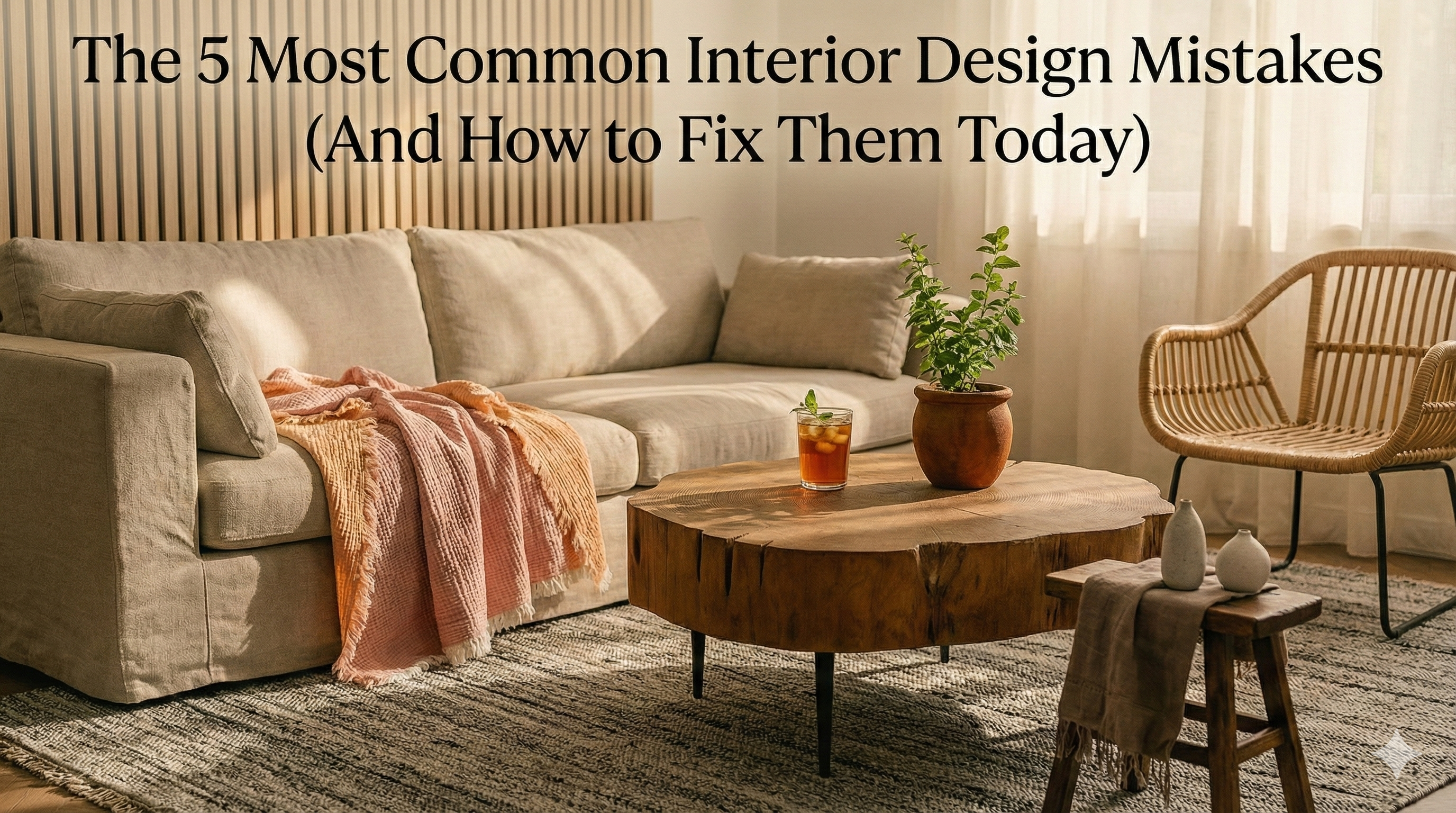Diseñar el interior de un restaurante de sushi consiste en crear una atmósfera que encarne la esencia de la cultura, la gastronomía y las experiencias gastronómicas japonesas. Se trata de un delicado equilibrio entre elegancia, simplicidad y funcionalidad, que garantiza una experiencia memorable para sus comensales. A continuación, se detallan los aspectos clave a considerar:
1. Público objetivo:
- ¿Quiénes son sus clientes principales? ¿Son jóvenes profesionales, familias, turistas o un grupo demográfico específico?
- ¿Qué tipo de ambiente prefieren? ¿Moderno, tradicional, informal o sofisticado?
- ¿Cuáles son sus hábitos y preferencias gastronómicas? ¿Prefieren comidas rápidas, informales o para ocasiones especiales?
2. Concepto y tema:
Japonés tradicional:

Público objetivo:
- Turistas que buscan una experiencia cultural inmersiva.
- Generaciones mayores nostálgicas de la auténtica comida japonesa.
- Personas interesadas en las artes y la cultura tradicionales japonesas.
- Elementos de diseño tradicionales: biombos shoji, tatamis, rollos de caligrafía, árboles bonsái y jardines de rocas.
- Materiales naturales: Madera oscura, bambú, piedra y linternas de papel.
- Paleta de colores: Tonos ricos y profundos como negro, rojo, dorado y matices de madera natural.
- Comedor formal: menús establecidos, comidas de varios platos y énfasis en la presentación y la etiqueta.
- Auténtica cocina japonesa: platos tradicionales preparados con meticuloso cuidado y utilizando técnicas específicas.
- Cenas para ocasiones especiales: celebraciones, cenas de negocios y reuniones íntimas.
Minimalista moderno:

Público objetivo:
- Entusiastas del diseño que aprecian la estética elegante y la funcionalidad.
- Jóvenes profesionales que buscan una experiencia gastronómica elegante y moderna.
- Clientela internacional atraída por las sensibilidades del diseño moderno.
- Decoración minimalista: ornamentación limitada, formas geométricas y enfoque en la funcionalidad.
- Materiales modernos: Hormigón, vidrio, metal y maderas de alta calidad con acabados suaves.
- Paleta de colores monocromática: negro, blanco, gris y tonos apagados con toques ocasionales de color.
- Cocina moderna: platos innovadores con énfasis en la presentación, ingredientes de calidad y emplatado artístico.
- Platos para compartir: Fomentando las comidas sociales y una variedad de sabores.
- Restaurante elegante o restaurante informal de alto nivel: dependiendo del concepto específico, podría variar desde sofisticados menús de degustación hasta restaurantes informales de alta calidad.

-
Público objetivo:
- Comedores aventureros que buscan combinaciones de sabores únicas e inesperadas.
- Los grupos demográficos más jóvenes se sienten atraídos por experiencias gastronómicas eclécticas y modernas.
- Aquellos que buscan un cambio con respecto a la cocina tradicional y un ambiente más lúdico.
-
Ambiente: Ecléctico, vibrante y divertido con una mezcla de influencias culturales.
- Decoración combinable: mezcla elementos japoneses con otros estilos como el industrial, el bohemio o el tropical.
- Colores y patrones atrevidos: experimentando con combinaciones de colores, texturas y piezas llamativas.
- Iluminación única: creación de una atmósfera dinámica con luces colgantes, letreros de neón o luces de cadena.

- Hábitos alimenticios:
-
- Cocina fusión: Mezclando ingredientes y técnicas japonesas con sabores y platos de otras culturas.
- Platos pequeños y comidas estilo tapas: fomentando la experimentación y el compartir.
- De informal a informal de alto nivel: dependiendo del concepto específico, la atmósfera puede variar desde relajada y divertida hasta más refinada y sofisticada.

-
Público objetivo: Personas que buscan autenticidad, una vida consciente y la apreciación de la imperfección. Esto podría incluir:
- Jóvenes profesionales: atraídos por la atmósfera relajante después de un largo día.
- Artistas y creativos: inspirados en la belleza cruda y los elementos orgánicos.
- Demografía madura: apreciación de la elegancia atemporal y la conexión con la naturaleza.
-
Ambiente: Rústico, íntimo y acogedor, imperfección.
- Materiales Naturales: Madera recuperada, vigas vistas, cerámica artesanal.

- Paleta de colores terrosos: verdes apagados, marrones, grises e índigo.
- Decoración minimalista: se centra en los elementos esenciales, resaltando las texturas naturales.
-
Hábitos alimenticios:
- Comidas pausadas: Fomentar la alimentación consciente y saborear la experiencia.
- Platos pequeños y para compartir: fomentando la conexión y la conversación.
- Centrarse en ingredientes de temporada: de origen local, resaltando los sabores naturales.
- Japonés:

-
Público objetivo: Personas interesadas en el diseño que valoran la funcionalidad, la simplicidad y la calidad. Esto podría incluir:
- Millennials y jóvenes profesionales: atraídos por el minimalismo elegante y la estética instagrameable.
- Minimalistas y habitantes urbanos: aprecian las líneas limpias y el uso eficiente del espacio.
- Público internacional: Atraído por la fusión de las sensibilidades de diseño escandinavas y japonesas.
-
Ambiente: limpio, moderno y elegante sin esfuerzo.
- Espacios amplios y luminosos: planos de planta abiertos, ventanas grandes, luz natural.
- Materiales naturales con toques modernos: Madera clara, detalles en hormigón, acabados en metal negro.
- Paleta de colores neutros: blanco, gris, beige con toques de colores apagados.
-
Hábitos alimenticios:
- Bocadillos rápidos y comidas informales: opciones rápidas pero de alta calidad para el estilo de vida moderno.
- La presentación es clave: platos visualmente atractivos con líneas limpias y emplatados minimalistas.
- Cocina Fusión: Mezcla de técnicas japonesas con sabores internacionales.
3. Paleta de colores e iluminación: Cómo crear el ambiente perfecto para tu restaurante de sushi
El color y la iluminación son cruciales para crear el ambiente ideal para tu restaurante de sushi. A continuación, profundizamos en cada aspecto:
3.1 Paleta de colores:
Tonos naturales:
- Colores: Marrones terrosos, beige, blancos cálidos y verdes suaves.
- Sensación: Calmante, acogedor y acogedor. Perfecto para crear una sensación de paz y serenidad, ideal para temas tradicionales japoneses.
- Materiales: Madera, bambú, piedra y tejidos naturales como el lino y el algodón.
- Ejemplo: imagine un restaurante de sushi con paredes revestidas de madera, pisos de bambú y manteles beige adornados con patrones florales tradicionales japoneses.
Neutrales minimalistas:
- Colores: Negro, gris, blanco y sutiles tonos metálicos.
- Sensación: Elegante, moderna y sofisticada. Ideal para crear una estética limpia y minimalista, perfecta para temas modernos o de fusión.
- Materiales: Metal, vidrio, hormigón pulido y tejidos de alta calidad como cuero o terciopelo.
- Ejemplo: piense en un restaurante de sushi con elegantes sillas negras, pisos de concreto pulido, paredes blancas y una única pieza de arte moderno en un color vibrante.
Acentos atrevidos
- Colores: Tonos vibrantes como rojo, verde, azul o amarillo.
- Sensación: Enérgica, divertida y llamativa. Aporta un toque de personalidad y puede usarse para resaltar rasgos específicos.
- Materiales: Obras de arte, telas de tapicería, detalles decorativos o incluso artefactos de iluminación.
- Ejemplo: considere usar una pared con acento rojo vibrante detrás de la barra de sushi, cojines coloridos en las sillas o un patrón geométrico divertido en el piso.
3.2 Iluminación:
Cálido y natural:

- Iluminación: Iluminación suave y difusa que imita la luz natural. Utilice lámparas colgantes, faroles o rieles de luz con bombillas de tonos cálidos. : Pantallas de papel de forma irregular.

Pantalla de papel con forma redondeada irregular
- Sensación: Íntima, acogedora y relajante. Perfecta para crear un ambiente acogedor y realzar las texturas naturales.
- Ejemplos: faroles de papel tradicionales, lámparas colgantes de madera o iluminación de riel con bombillas de color blanco cálido regulables.
Iluminación de enfoque:

- Iluminación: Focos direccionales o iluminación de acento utilizados para resaltar áreas u objetos específicos.
- Sensación: atrae la atención hacia los puntos focales, creando interés visual y resaltando elementos clave.
- Ejemplos: focos en la barra de sushi para resaltar el arte de los chefs, luces acentuadas en obras de arte o elementos decorativos o iluminación ascendente para enfatizar la altura del techo.
Opciones regulables:

- Iluminación: utilice dispositivos de iluminación regulables para permitir que los huéspedes ajusten el brillo según sus preferencias.
- Sensación: Proporciona flexibilidad y control sobre la atmósfera, permitiendo a los invitados crear el ambiente perfecto para su experiencia gastronómica.
- Ejemplos: luces colgantes regulables, iluminación de riel con interruptores de atenuación o bombillas inteligentes que se pueden controlar con una aplicación de teléfono inteligente.
Combinando color e iluminación:
- Tonos naturales + iluminación cálida: crea un ambiente tranquilo y acogedor, perfecto para un restaurante japonés tradicional.

- Neutrales minimalistas + iluminación focalizada: crea un ambiente elegante y moderno, resaltando características clave en un entorno minimalista.

- Acentos atrevidos + iluminación regulable: crea una atmósfera divertida y adaptable, que permite a los invitados ajustar el estado de ánimo a su gusto.

Al combinar cuidadosamente el color y la iluminación, puede crear una experiencia en su restaurante de sushi visualmente atractiva, emocionalmente cautivadora y perfectamente adaptada a la temática elegida. Recuerde: la clave está en crear un espacio armonioso y memorable que prepare el escenario para una experiencia gastronómica deliciosa.
4. Materiales y texturas:
-
Madera: El bambú, el cerezo y el cedro se utilizan comúnmente para pisos, muebles y detalles decorativos.
-

-
Piedra: La pizarra, el granito y el mármol ofrecen una superficie sofisticada y duradera para encimeras y paredes.

- Textiles: Las telas de lino, seda y algodón añaden calidez y textura a los asientos, manteles y tapices.


5. Muebles y asientos:
- Sushi Bar: un espacio central que ofrece una experiencia gastronómica interactiva y muestra el arte de la preparación del sushi.
- Mesas: Elija mesas con diseños japoneses tradicionales o estilos contemporáneos que complementen la estética general.
- Asientos: Sillas cómodas o tatamis en el suelo ofrecen una variedad de opciones para sentarse.
6. Decoración y acentos:
- Arte tradicional: Cuelgue pergaminos, grabados en madera o arreglos florales tipo ikebana.
- Jardín Zen: crea un mini jardín zen con arena, rocas y plantas en miniatura para darle un toque relajante.
Artefactos de iluminación: Las linternas japonesas, las luces colgantes con detalles de madera o bambú y las linternas de papel añaden carácter.

Lámpara de mesa de papel, forma de diamante
- Plantas: Incorpore árboles bonsái, plantas de bambú u otras plantas verdes para darle un toque de naturaleza.
7. Sostenibilidad:
- Materiales ecológicos: utilice materiales reciclados o sostenibles como bambú y madera reciclada.

- Eficiencia energética: utilice iluminación y electrodomésticos energéticamente eficientes.
- Reducción de residuos: Implementar prácticas para reducir el desperdicio de alimentos y el reciclaje.
8. Marca e identidad:
- Marca consistente: mantenga una identidad de marca consistente en todo el diseño interior, desde el logotipo y la combinación de colores hasta los muebles y la decoración.
- Identidad única: crea una identidad única y memorable para tu restaurante, diferenciándolo de sus competidores.
Recuerde, la clave es crear una experiencia armoniosa y memorable para sus invitados, que refleje la belleza y la elegancia de la cocina y la cultura japonesas. Esta guía detallada le ayudará a explorar el mundo del diseño de interiores de restaurantes de sushi y a crear un espacio que cautive y deleite a sus clientes.

